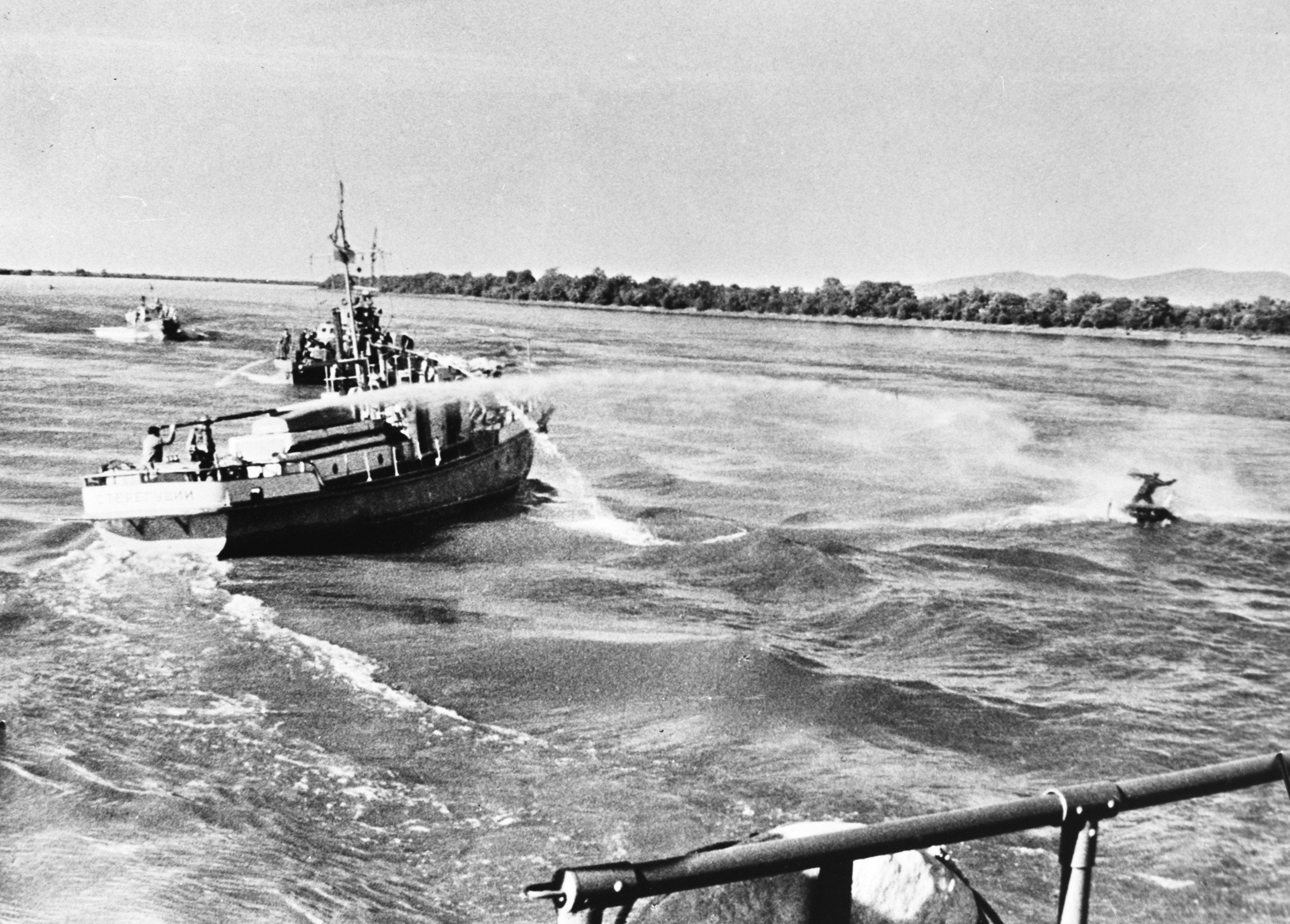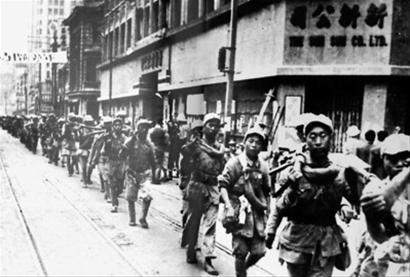|
68th Motorized Infantry Brigade (People's Republic Of China)
The 73rd Division () was created in February 1949 under ''the Regulation of the Redesignations of All Organizations and Units of the Army'', issued by Central Military Commission on November 1, 1948,《中央军委关于统一全军组织及部队番号的规定》, http://blog.sina.com.cn/s/blog_7254c7350100xb56.html basing on the 19th Division, 7th Column of the Huadong Field Army. Its history can be traced to the Riverine Detachment of 7th Division, New Fourth Army, formed in February 1943. The division was part of the 25th Corps. Under the flag of the 73rd Division, it was engaged in several major battles in the Chinese Civil War, including the Menglianggu Campaign, Huaihai Campaign, and Shanghai Campaign. In July 1952, the division was transferred to 23rd Corps and was deployed into Korea in September. In October 1952, Artillery Regiment was activated, which was later redesignated as 349th Artillery Regiment from 1953. The division pulled out from North Korea in March ... [...More Info...] [...Related Items...] OR: [Wikipedia] [Google] [Baidu] |
People's Republic Of China
China, officially the People's Republic of China (PRC), is a country in East Asia. It is the world's most populous country, with a population exceeding 1.4 billion, slightly ahead of India. China spans the equivalent of five time zones and borders fourteen countries by land, the most of any country in the world, tied with Russia. Covering an area of approximately , it is the world's third largest country by total land area. The country consists of 22 provinces, five autonomous regions, four municipalities, and two Special Administrative Regions (Hong Kong and Macau). The national capital is Beijing, and the most populous city and financial center is Shanghai. Modern Chinese trace their origins to a cradle of civilization in the fertile basin of the Yellow River in the North China Plain. The semi-legendary Xia dynasty in the 21st century BCE and the well-attested Shang and Zhou dynasties developed a bureaucratic political system to serve hereditary monarchies, or dyna ... [...More Info...] [...Related Items...] OR: [Wikipedia] [Google] [Baidu] |
Third Field Army
The Third Field Army was one of the five main forces of the Communist Party's People's Liberation Army during the Chinese Civil War. It was established in early 1949. Initially known as the East China Field Army, it was formed by the New Fourth Army and the Eighth Route Army troops stationed in Shandong Province, a gradual adaptation of the expansion. It took control of the troops in eastern China, with Chen Yi as its commander. It comprised the 7th, 8th, 9th, and 10th Armies plus the headquarters of the special technical troops, with a total of 580,000 men. Forces associated with the Third Field Army included:See Witson 1972 *The 7th Army, Commander Wang Jian'an, political commissar Tan Qilong, chief of staff Li Yingxi: **21st Corps (including 61, 62, 63rd Divisions), commander Teng Haiqing, political commissar Kang Zhiqiang **22nd Corps (including the 64th, 65th, 66th Divisions), commander Sun Jixian, political commissar Ding Qiusheng ** 23rd Corps (including 67th, 68th, 69th ... [...More Info...] [...Related Items...] OR: [Wikipedia] [Google] [Baidu] |
135th Motorised Rifle Division
The 135th Motor Rifle Division was a mechanized infantry division of the Soviet Army during the Cold War. The division was formed in 1960 as a mobilization division in Luhansk. It became a regular division in 1968 and was transferred to Lesozavodsk. In 1989, it was renamed the 130th Machine Gun Artillery Division (Military Unit Number 92910) and continued to serve in the Russian Ground Forces. It was reduced to the 245th Weapons and Equipment Storage Base in 2009. History On 22 November 1960, the 135th Motor Rifle Division was activated as a mobilization division in Luhansk. It was co-located with the 4th Guards Motor Rifle Division. In April 1968, the division became a regular unit and was transferred to Lesozavodsk as a result of increased Sino-Soviet tensions. The division's 199th Motor Rifle Regiment fought in the Damansky Island incident in March 1969 during the Sino-Soviet border conflict, when they were sent into the fight on 15 March to prevent Chinese capture of the i ... [...More Info...] [...Related Items...] OR: [Wikipedia] [Google] [Baidu] |
Sino-Soviet Border Conflict
The Sino-Soviet border conflict was a seven-month undeclared military conflict between the Soviet Union and China in 1969, following the Sino-Soviet split. The most serious border clash, which brought the world's two largest communist states to the brink of war, occurred in March 1969 near Zhenbao (Damansky) Island on the Ussuri (Wusuli) River, near Manchuria. The conflict resulted in a ceasefire, which led to a return to the status quo. Background History Under the governorship of Sheng Shicai (1933–1944) in Northwest China's Xinjiang Province, China's Kuomintang recognized for the first time the ethnic category of a Uyghur people by following Soviet ethnic policy. That ethnogenesis of a "national" people eligible for territorialized autonomy broadly benefited the Soviet Union, which organized conferences in Fergana and Semirechye (in Soviet Central Asia) to cause "revolution" in Altishahr (southern Xinjiang) and Dzungaria (northern Xinjiang). Both the Soviet Union and the ... [...More Info...] [...Related Items...] OR: [Wikipedia] [Google] [Baidu] |
2nd Independent Division Of Liaoning Provincial Military District
2nd Independent Division of Heilongjiang Provincial Military District ()(1st Formation) was formed on June 30th 1966 from the Public Security Contingent of Heilongjiang Heilongjiang () formerly romanized as Heilungkiang, is a province in northeast China. The standard one-character abbreviation for the province is (). It was formerly romanized as "Heilungkiang". It is the northernmost and easternmost province ... province. The division was composed of seven regiments (5th to 11th) and an independent battalion. In February 1969 it exchanged its position and designation with 2nd Independent Division of Liaoning Provincial Military District and became the second formation of 2nd Independent Division of Liaoning Provincial Military District(). In 1976 the division was disbanded. References {{People's Liberation Army Divisions IH2 Military units and formations established in 1966 Military units and formations disestablished in 1976 ... [...More Info...] [...Related Items...] OR: [Wikipedia] [Google] [Baidu] |
23rd Group Army
The 23rd Army was an army of the Chinese People's Liberation Army, active from 1949. The army originally consisted of the 67th, 68th Division, and 69th Divisions. However, the 68th Division was disestablished in August 1952. It was active during the Korean War. The People's Republic had planned to rotate all troops in Korea by the end of 1953, and the Chinese Central Military Commission authorized the 23rd, 24th and 46th Corps to replace 20th, 27th and 42nd Corps by September 1952.. In Korea, under Commander Zhong Guochu, with Commissar Lu Sheng, it was assigned to east coast defence duties with the 67th, 69th and 73rd Divisions assigned. It was one of the eight armies identified by the U.S. Central Intelligence Agency as being active in the Shenyang Military Region as of 15 March 1967. Dennis Blasko's 2002 RAND chapter identified it in the Shenyang MR with its headquarters in Harbin Harbin (; mnc, , v=Halbin; ) is a sub-provincial city and the provincial capital ... [...More Info...] [...Related Items...] OR: [Wikipedia] [Google] [Baidu] |
Shanghai Campaign
The Shanghai Campaign was a series of battles fought between the nationalists and the communists for the control of Shanghai, the largest city in China in the latter stage of the Chinese Civil War, and resulted in the city being taken over by the communists, who enjoyed numerical superiority. Prelude With a population of six million, Shanghai was the largest city in China in 1949 and provided around a third of the total GDP of China by that time. Both the communists and the nationalists believed that World War III was a real possibility and this perception influenced the strategic decisions of both sides. The nationalists who defended the city had hoped that by using the resources of China's wealthiest city, they could last until World War III when foreign intervention would occur. With foreign intervention, not only they would be able to defend the city, but also counterattack and take China back. If the city could not last until World War III, the nationalists could with ... [...More Info...] [...Related Items...] OR: [Wikipedia] [Google] [Baidu] |
Menglianggu Campaign
The Menglianggu campaign () was fought between the nationalists and the communists during the Chinese Civil War in the post-World War II era and resulted in communist victory. The campaign was later used by the communists as a specific battle example in their military science and history, as well as a propaganda piece. The battle mainly took place in Menglianggu of Linyi region in Shandong Province. Prelude From March 1947 the Nationalists had abandoned their original plan of all-out assault on every communist position; instead, they adjusted their strategy to a much more realistic one: concentrating on attacking the communists in northern Shanxi and Shandong. In the Shandong theater of war, Generalissimo Chiang Kai-shek named Gu Zhutong, the commander-in-chief of the National Revolutionary Army, as the commander-in-chief at the front line, setting up his headquarters in Xuzhou. Gu Zhutong had 24 army-sized reorganized divisions totaling more than 60 division-sized reorganize ... [...More Info...] [...Related Items...] OR: [Wikipedia] [Google] [Baidu] |
25th Corps (People's Republic Of China)
Fifth is the ordinal form of the number five. Fifth or The Fifth may refer to: * Fifth Amendment to the United States Constitution, as in the expression "pleading the Fifth" * Fifth column, a political term * Fifth disease, a contagious rash that spreads in school-aged children * Fifth force, a proposed force of nature in addition to the four known fundamental forces * Fifth (Stargate), a robotic character in the television series ''Stargate SG-1'' * Fifth (unit), a unit of volume used for distilled beverages in the U.S. * Fifth-generation programming language * The fifth in a series, or four after the first: see ordinal numbers * 1st Battalion, 5th Marines * The Fraction 1/5 * The royal fifth (Spanish and Portuguese), an old royal tax of 20% Music * A musical interval (music); specifically, a ** perfect fifth ** diminished fifth ** augmented fifth * Quintal harmony, in which chords concatenate fifth intervals (rather than the third intervals of tertian harmony) * Fifth (chord) * ... [...More Info...] [...Related Items...] OR: [Wikipedia] [Google] [Baidu] |
New Fourth Army
The New Fourth Army () was a unit of the National Revolutionary Army of the Republic of China established in 1937. In contrast to most of the National Revolutionary Army, it was controlled by the Chinese Communist Party and not by the ruling Kuomintang. The New Fourth Army and the Eighth Route Army were the two main communist forces from 1938. The New Fourth Army was active south of the Yangtze River (Chang Jiang), while the Eighth Route Army was based in Yan'an in the northwest. Members of the New Fourth Army wore their badges on the left arm, with ''"N4A"'' and the soldier's unit and name listed on the badge. After the Xi'an Incident, the Kuomintang led by Chiang Kai-shek and the Chinese Communist Party led by Mao Zedong formed a United Front against Japan, which was already in control of Manchuria and pushing into North China. The Marco Polo Bridge Incident in July 1937 marked the beginning of the Sino-Japanese War (1937-1945). In October, 1937, an announcement was made th ... [...More Info...] [...Related Items...] OR: [Wikipedia] [Google] [Baidu] |
Leng Pengfei , a fictional plateau
Mans leng styll.
{{disambiguation ...
Leng may refer to: * Leng (surname) (冷), a Chinese surname * Leng (plateau) Leng may refer to: * Leng (surname) (冷), a Chinese surname * Leng (plateau) Leng may refer to: * Leng (surname) Leng is the Mandarin pinyin and Wade–Giles romanization of the Chinese surname written in Chinese character and Vietnamese surna ... [...More Info...] [...Related Items...] OR: [Wikipedia] [Google] [Baidu] |

